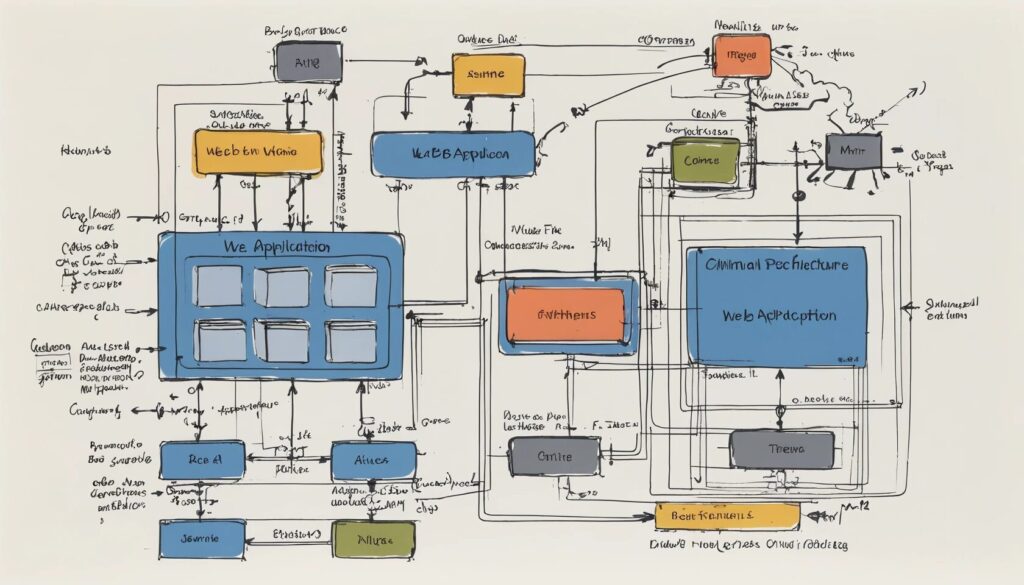The Future of Web Application Architecture in 2025
Web application architecture has never been more dynamic. With AI in web development taking center stage, developers now have tools that practically write the code for them—because, let’s be honest, who wants to do all that work manually? As we move into 2025, cutting-edge advancements like serverless computing and microservices architecture are reshaping how applications are built, deployed, and scaled.
But don’t be fooled—just because AI is doing the heavy lifting doesn’t mean you can throw best practices out the window. Scalability, security, and cloud-native development remain non-negotiable. If you’re not keeping up, your app might as well be running on dial-up.
Key Components of Modern Web Application Architecture
- Web Browser: The user-facing layer where all the magic (or frustration) happens.
- Web Server: Handles requests, processes business logic, and makes sure your app doesn’t crash.
- Database Server: Stores, retrieves, and manages application data because, let’s face it, data is king.
Each of these components must work together seamlessly, or users will bounce faster than a rubber ball on concrete. With AI-driven optimizations, web browsers now deliver more personalized experiences, while backend servers leverage automation to enhance response times.
Why Microservices Architecture is Taking Over
- Scalability: Easily scale individual services without breaking the entire system.
- Fault Isolation: A failure in one service doesn’t bring down the whole application.
- Faster Development: Teams can work on different services simultaneously.
Gone are the days of monolithic nightmares where a single broken function could bring down the entire app. Microservices architecture allows developers to build applications as a collection of independent, modular services. This means updates can be deployed faster, making businesses more agile. Plus, who doesn’t love the idea of debugging just one small service instead of an entire tangled codebase?
Serverless Computing: The End of Infrastructure Nightmares
- Cost Efficiency: Pay only for what you use—no need to maintain idle servers.
- Automatic Scaling: Resources expand and contract based on demand.
- Reduced Management: No more sleepless nights troubleshooting infrastructure.
With serverless computing, infrastructure management is someone else’s problem. Developers can focus on writing code instead of wrestling with servers. Platforms like AWS Lambda and Google Cloud Functions allow businesses to execute functions on demand, optimizing costs and performance. If you’re still manually managing servers in 2025, you might as well be using floppy disks.
AI in Web Development: Smarter Apps, Less Effort
- Automated Code Generation: AI tools like GitHub Copilot assist developers in writing efficient code.
- Personalized User Experiences: AI-driven recommendations enhance engagement.
- Performance Optimization: AI monitors and improves app speed dynamically.
AI is revolutionizing web development, turning tedious coding tasks into a thing of the past. Tools like OpenAI’s GPT-4 and Figma’s AI-powered design assistants are streamlining development workflows. From chatbots that actually understand users to real-time performance analysis, AI is making applications not just smarter, but also more intuitive.
Web Application Best Practices for 2025
- Implement Immutable Infrastructure: Replace, don’t tinker—reduce bugs and streamline deployments.
- Prioritize Security: Threats evolve, and so should your defenses.
- Optimize for Cloud Environments: Design applications that thrive in cloud-native ecosystems.
- Leverage CI/CD Pipelines: Automate testing and deployment for seamless updates.
Best practices aren’t just buzzwords—they’re the difference between a high-performing app and a disaster waiting to happen. Immutable infrastructure ensures consistency, while robust security measures prevent breaches. Whether you’re using Terraform for infrastructure as code or Kubernetes for container orchestration, the goal remains the same: efficiency, scalability, and reliability.
Final Thoughts: Adapt or Get Left Behind
The web application landscape is evolving at breakneck speed. AI, serverless computing, and microservices architecture are no longer futuristic concepts—they’re the present reality. Developers who fail to embrace these advancements risk being outpaced by competitors who build faster, smarter, and more scalable applications.
It’s time to rethink how we design and deploy web applications. Whether you’re launching a new project or modernizing an existing one, staying ahead of these trends will ensure your application remains competitive in 2025 and beyond.
